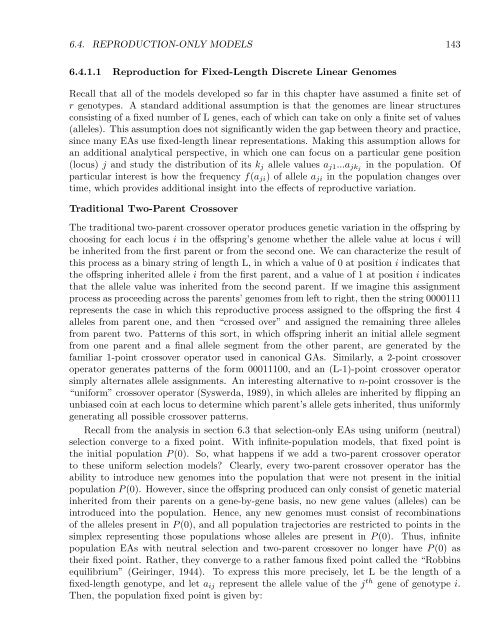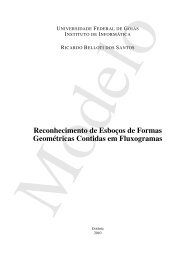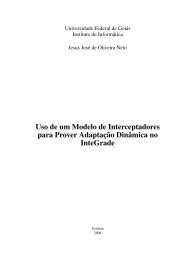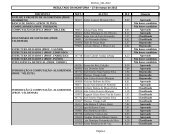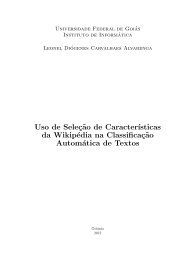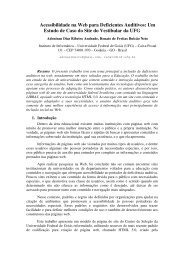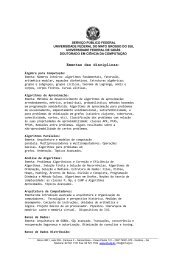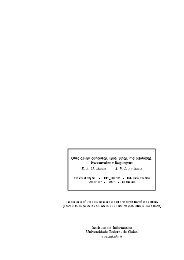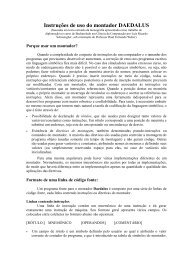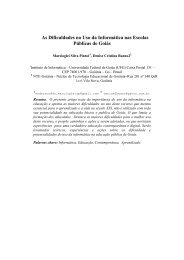Evolutionary Computation : A Unified Approach
Evolutionary Computation : A Unified Approach
Evolutionary Computation : A Unified Approach
Create successful ePaper yourself
Turn your PDF publications into a flip-book with our unique Google optimized e-Paper software.
6.4. REPRODUCTION-ONLY MODELS 143<br />
6.4.1.1 Reproduction for Fixed-Length Discrete Linear Genomes<br />
Recall that all of the models developed so far in this chapter have assumed a finite set of<br />
r genotypes. A standard additional assumption is that the genomes are linear structures<br />
consisting of a fixed number of L genes, each of which can take on only a finite set of values<br />
(alleles). This assumption does not significantly widen the gap between theory and practice,<br />
since many EAs use fixed-length linear representations. Making this assumption allows for<br />
an additional analytical perspective, in which one can focus on a particular gene position<br />
(locus) j and study the distribution of its k j allele values a j1 ...a jkj in the population. Of<br />
particular interest is how the frequency f(a ji ) of allele a ji in the population changes over<br />
time, which provides additional insight into the effects of reproductive variation.<br />
Traditional Two-Parent Crossover<br />
The traditional two-parent crossover operator produces genetic variation in the offspring by<br />
choosing for each locus i in the offspring’s genome whether the allele value at locus i will<br />
be inherited from the first parent or from the second one. We can characterize the result of<br />
this process as a binary string of length L, in which a value of 0 at position i indicates that<br />
the offspring inherited allele i from the first parent, and a value of 1 at position i indicates<br />
that the allele value was inherited from the second parent. If we imagine this assignment<br />
process as proceeding across the parents’ genomes from left to right, then the string 0000111<br />
represents the case in which this reproductive process assigned to the offspring the first 4<br />
alleles from parent one, and then “crossed over” and assigned the remaining three alleles<br />
from parent two. Patterns of this sort, in which offspring inherit an initial allele segment<br />
from one parent and a final allele segment from the other parent, are generated by the<br />
familiar 1-point crossover operator used in canonical GAs. Similarly, a 2-point crossover<br />
operator generates patterns of the form 00011100, and an (L-1)-point crossover operator<br />
simply alternates allele assignments. An interesting alternative to n-point crossover is the<br />
“uniform” crossover operator (Syswerda, 1989), in which alleles are inherited by flipping an<br />
unbiased coin at each locus to determine which parent’s allele gets inherited, thus uniformly<br />
generating all possible crossover patterns.<br />
Recall from the analysis in section 6.3 that selection-only EAs using uniform (neutral)<br />
selection converge to a fixed point. With infinite-population models, that fixed point is<br />
the initial population P (0). So, what happens if we add a two-parent crossover operator<br />
to these uniform selection models Clearly, every two-parent crossover operator has the<br />
ability to introduce new genomes into the population that were not present in the initial<br />
population P (0). However, since the offspring produced can only consist of genetic material<br />
inherited from their parents on a gene-by-gene basis, no new gene values (alleles) can be<br />
introduced into the population. Hence, any new genomes must consist of recombinations<br />
of the alleles present in P (0), and all population trajectories are restricted to points in the<br />
simplex representing those populations whose alleles are present in P (0). Thus, infinite<br />
population EAs with neutral selection and two-parent crossover no longer have P (0) as<br />
their fixed point. Rather, they converge to a rather famous fixed point called the “Robbins<br />
equilibrium” (Geiringer, 1944). To express this more precisely, let L be the length of a<br />
fixed-length genotype, and let a ij represent the allele value of the j th gene of genotype i.<br />
Then, the population fixed point is given by:


